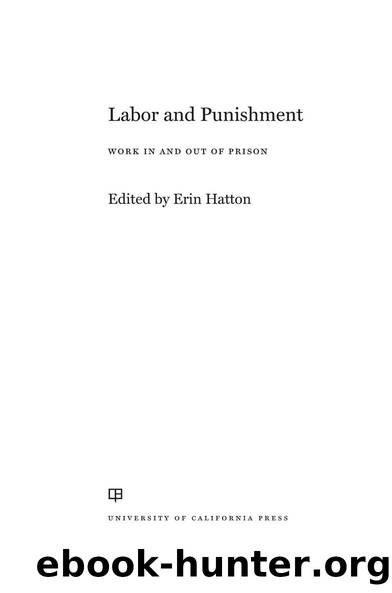Labor and Punishment by Erin Hatton

Author:Erin Hatton [Hatton, Erin]
Language: eng
Format: epub
ISBN: 9780520305342
Barnesnoble:
Publisher: University of California Press
Published: 2021-05-25T00:00:00+00:00
4 The Carceral Labor Continuum
BEYOND THE PRISON LABOR/FREE LABOR DIVIDE
Noah D. Zatz
Prison labor is persistently scandalous. Incarcerated workers are at once sharply distinguished from âfree laborâ by their incarceration and yet intertwined with it through their work. For incarcerated workers to receive the pay, protections, and status accorded to free citizen-workers would violate the political demand of âless eligibilityâ (Melossi 2003); that principle requires that the state impose on those suffering criminal punishment conditions that visibly and viscerally convey degradation relative to those marked as âlaw abiding.â Yet imposing that degradation also threatens free labor (McLennan 2008). It creates an alternative source of cheap, subordinated labor power, and it contradicts the notion that productive work engenders claims to citizenship.
To contain this scandal, the United States constructed a legal and institutional framework for prison labor that purported to carve âa wide moat between the sphere of the market and that of legal punishmentâ (McLennan 2008, 5). This framework simultaneously denies that incarcerated workers are workers at all (Zatz 2008) and constrains their use as economic substitutes for free labor (McLennan 2008; Thompson 2011).
This settlement has always been incomplete and potentially unstable. Incarceration without work, or productive work, invites its own less-eligibility challenges to state-supported âidlenessâ (McLennan 2008; McBride 2007). Penal institutions and private capital alike have financial interests in tapping this captive labor pool. Recent decades have laid the groundwork for a resurgence in prison labor (Thompson 2011; Weiss 2001). Simultaneously, movements against contemporary racialized mass incarceration, including those led by incarcerated people claiming the mantle and tactics of striking workers (Bonsu 2017), have treated prison labor as symptomatic of the âNew Jim Crowâ (Alexander 2012), a broader betrayal of freedomâs promise.
This chapter questions a constant in the preceding sketch: the sharp distinction between prison labor and the free labor market outside. In contrast, I argue for a more capacious conception of âcarceral laborâ that sweeps in an array of work arrangements directly structured by the stateâs power to incarcerate. Prison laborâwork performed by those currently incarceratedâis carceral labor of a distinct and important kind. Nonetheless, scholars and critics rightly speak of a âcarceral stateâ anchored by penal incarceration but reaching far beyond it (Beckett and Murakawa 2012; Lynch 2012). So, too, should we situate prison labor within a more capacious analysis of how criminal law shapes and compels contemporary work, including ways that are integrated with that abstraction âthe labor market,â not fundamentally apart from or opposed to it.
The threat of state violence can hover over a workerâs head even if the worker is not in state custody, let alone custody as punishment for a crime. For instance, a traffic ticket spawns fines and fees, and the debtor unable to pay gets a choice: go to jail or âwork offâ the debt doing âcommunity serviceâ (Herrera et al. 2019). Or a âdiversionâ program allows a defendant to avoid prosecution, conviction, or punishment in exchange for compliant participation in âservicesâ offered as an alternative (McLeod 2012), such as working at a poultry processing plant as a purported method of drug rehabilitation (Harris and Walter 2017).
Download
This site does not store any files on its server. We only index and link to content provided by other sites. Please contact the content providers to delete copyright contents if any and email us, we'll remove relevant links or contents immediately.
| Biographies | Company Profiles |
| Economic History |
Pale Blue Dot by Carl Sagan(3995)
The Rules Do Not Apply by Ariel Levy(3897)
Goodbye Paradise(2949)
Delivering Happiness by Tony Hsieh(2917)
Liar's Poker by Michael Lewis(2805)
Into Thin Air by Jon Krakauer(2695)
Purple Cow by Seth Godin(2694)
Ogilvy on Advertising by David Ogilvy(2677)
Rogue Trader by Leeson Nick(2469)
The Airbnb Story by Leigh Gallagher(2363)
The Social Psychology of Inequality by Unknown(2304)
The Mind Map Book by Tony Buzan(2074)
Six Billion Shoppers by Porter Erisman(1995)
Bossypants by Tina Fey(1982)
Claridge's: The Cookbook by Nail Martyn & Erickson Meredith(1958)
All the President's Men by Carl Bernstein & Bob Woodward(1955)
Master of the Game by Sidney Sheldon(1876)
Alibaba by Duncan Clark(1751)
Wild Ride by Adam Lashinsky(1655)
